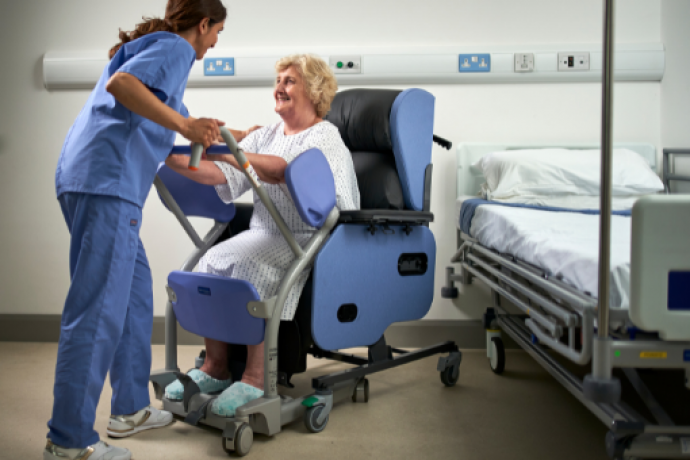
16th July 2025
Empowering clinicians with expert-led training on clinical seating, pressure injury prevention, and best practice.
Learn More

Let our online product finder guide you through our simple steps to choose the chairs that best meet your patient’s needs.
Seating Solution FinderThe Envelo cushion provides excellent pressure redistribution and comes as standard on all Seating Matters chairs, meeting the clinical needs of most clients.
Explore Envelo RangeSeating Matters specialises in clinical, therapeutic seating solutions designed to improve patient care and safety, offering products for pressure injury prevention, postural support, and mobility assistance in healthcare settings.
Learn MoreDiscover how Seating Matters has transformed lives with our innovative seating solutions - read our inspiring customer success stories now!
Customer StoriesUsed in academia, in clinical practice and with caregivers around the world to guide their practices around specialist seating.
Download Free HandbookIn the world of Occupational Therapy, precision and clarity in documentation can make all the difference. One of the most effective tools for structured clinical documentation is the SOAP note—an acronym for Subjective, Objective, Assessment, and Plan. While SOAP notes are widely used across therapy disciplines, their value in seating and positioning interventions is particularly significant. At Seating Matters, where our focus is on optimising posture, function, and comfort through clinically-based seating solutions, integrating SOAP notes ensures better client outcomes and communication across the care team.
S: Subjective – The Client’s Voice
This section captures the client's or caregiver’s perspective. When assessing seating needs, it’s critical to document:
>The client’s complaints of discomfort or pain in their current seating
>Perceived difficulties during daily activities (e.g., sliding forward, fatigue)
>Caregiver concerns about transfers, repositioning, or pressure injuries
Example:
“Client reports increased lower back pain after sitting for more than 30 minutes in current wheelchair. Caregiver notes difficulty repositioning client without assistance.”
O: Objective – What You Observe
This is where you record measurable and observable data during the seating assessment. Use this space to describe:
>Postural abnormalities (e.g., pelvic tilt, kyphosis, scoliosis)
>Skin integrity and risk of pressure injuries
>Current seating equipment and its limitations
>Functional status during activities in current setup
Example:
“Client presents with posterior pelvic tilt and mild thoracic kyphosis. Current seating shows no lateral trunk support. Observed frequent forward sliding within 10 minutes of upright sitting.”
A: Assessment – Clinical Interpretation
This section connects the dots. Based on subjective input and objective data, provide your clinical judgment:
>Identify issues with current seating that contribute to the client’s dysfunction or discomfort
>Highlight risks (e.g., pressure ulcers, reduced functional independence)
>Determine whether current seating supports therapeutic goals
“Client’s postural instability and lack of lateral support likely contributing to poor sitting tolerance and increased caregiver burden. Current wheelchair does not meet clinical needs for positioning and pressure management.”
Sign up to our mailing list to get practical tips and latest research delivered to your inbox!

P: Plan – What Comes Next
Outline your intervention strategy. For seating-related SOAP notes, the plan may include:
Trialing alternative seating systems like the Sorrento or Milano chair
Adjusting cushion or backrest configuration
Collaborating with a seating specialist or referring to a supplier
Scheduling follow-up for fit checks and client feedback
Example:
“Initiate trial with Sorrento tilt-in-space chair to improve pelvic positioning and reduce forward sliding. Educate caregiver on repositioning techniques. Review skin integrity in 1 week.”
Why SOAP Notes Matter for Seating
SOAP notes ensure that clinical reasoning is transparent and that interventions are tailored, traceable, and defensible. For therapists using Seating Matters equipment, structured documentation helps justify seating changes, enhances interprofessional communication, and supports funding or insurance claims.
By integrating SOAP notes into your seating assessments, you’re not just improving documentation—you’re elevating the standard of care.
Conclusion
Seating is more than just a chair—it’s a foundation for function, dignity, and quality of life. Using SOAP notes in your seating evaluations empowers you to make evidence-based decisions and advocate effectively for your clients.
Want help choosing the right chair for your client’s needs? Contact our Seating Specialists for a free consultation or explore our clinically-designed seating solutions at Seating Matters.
** Note - the purpose of this blog is to give an overview of the product with some tips to consider on its use. This is not intended to be a substitute for professional or medical advice, diagnosis, prescription or treatment and does not constitute medical or other professional advice. For advice with your personal health or that of someone in your care, consult your doctor or appropriate medical professional.
Take the next step to achieve clinical excellence and a 24 hour package of care for patients.

Arrange a free, no obligation assessment of clinical, therapeutic seating.

Schedule a call at a time that suits you to speak with our experts.

Download your copy of The Clinician's Seating Handbook

16th July 2025

12th May 2025

24th March 2025